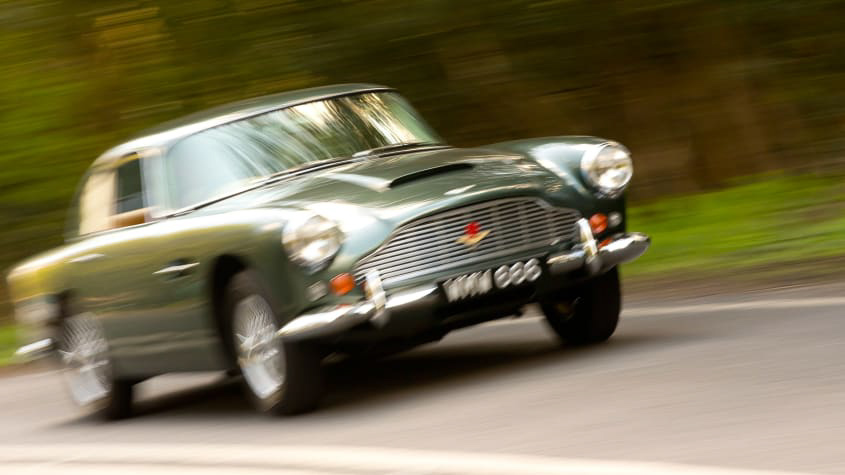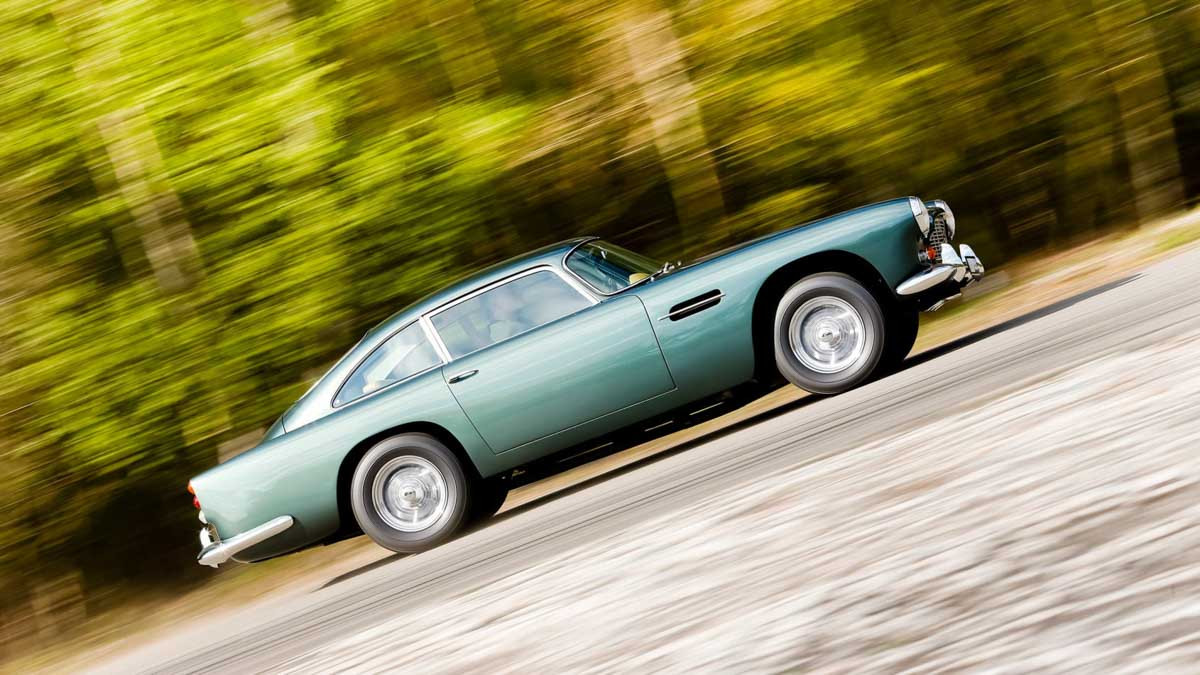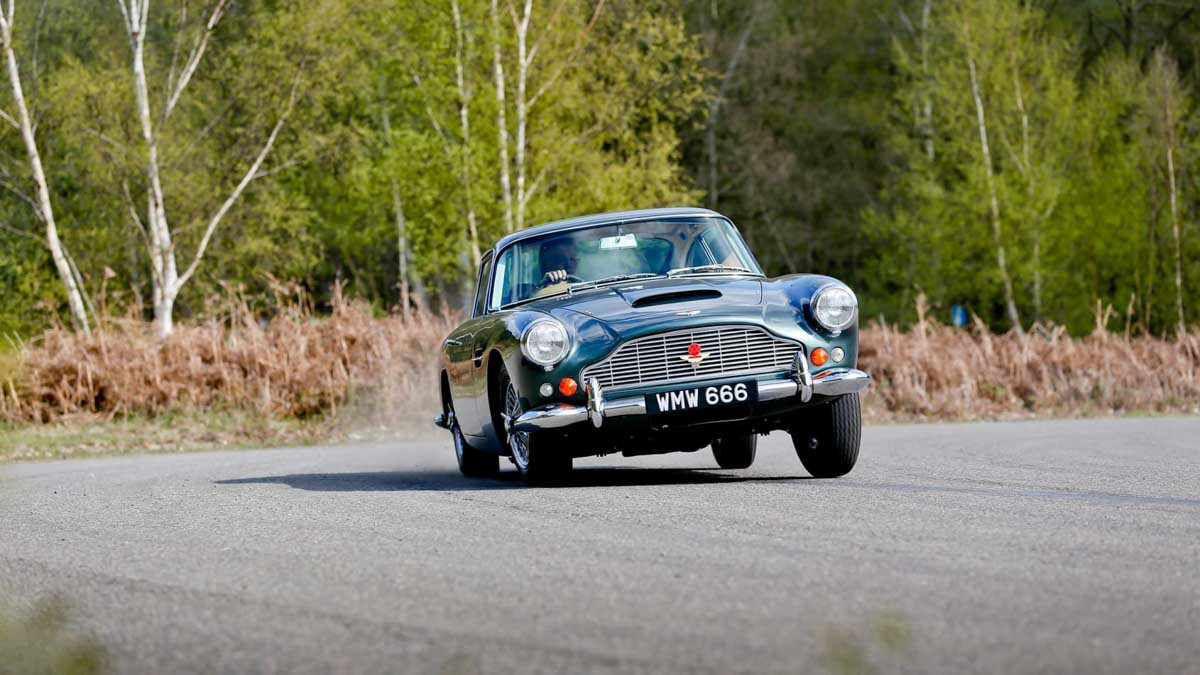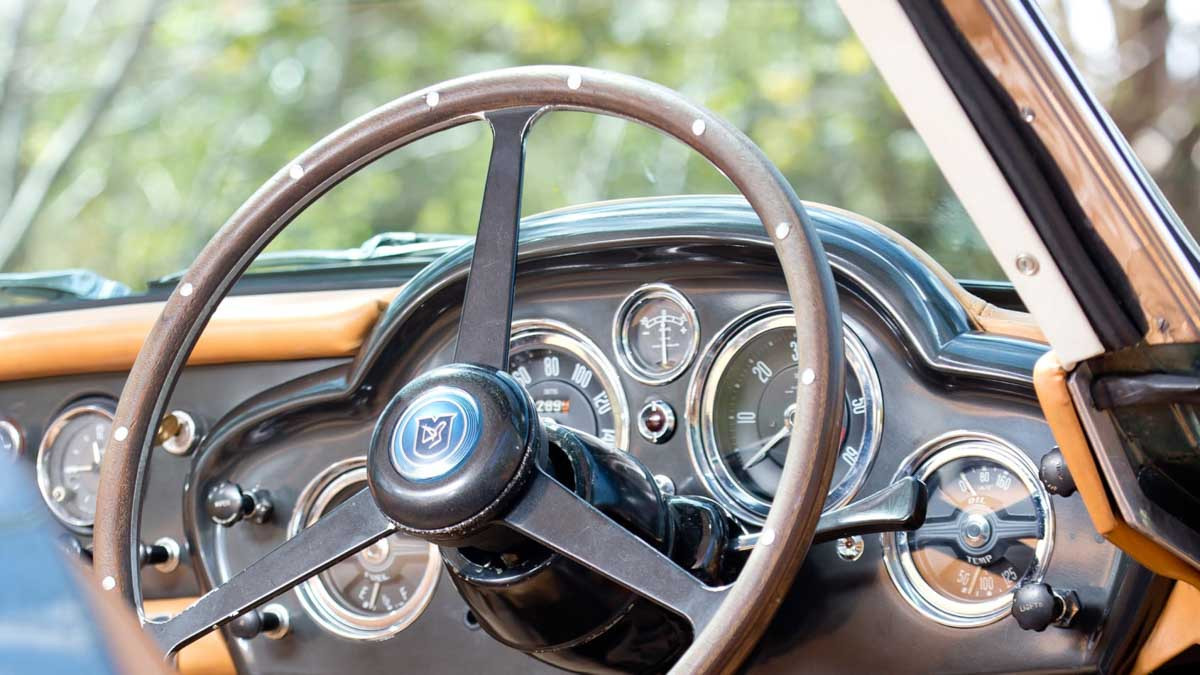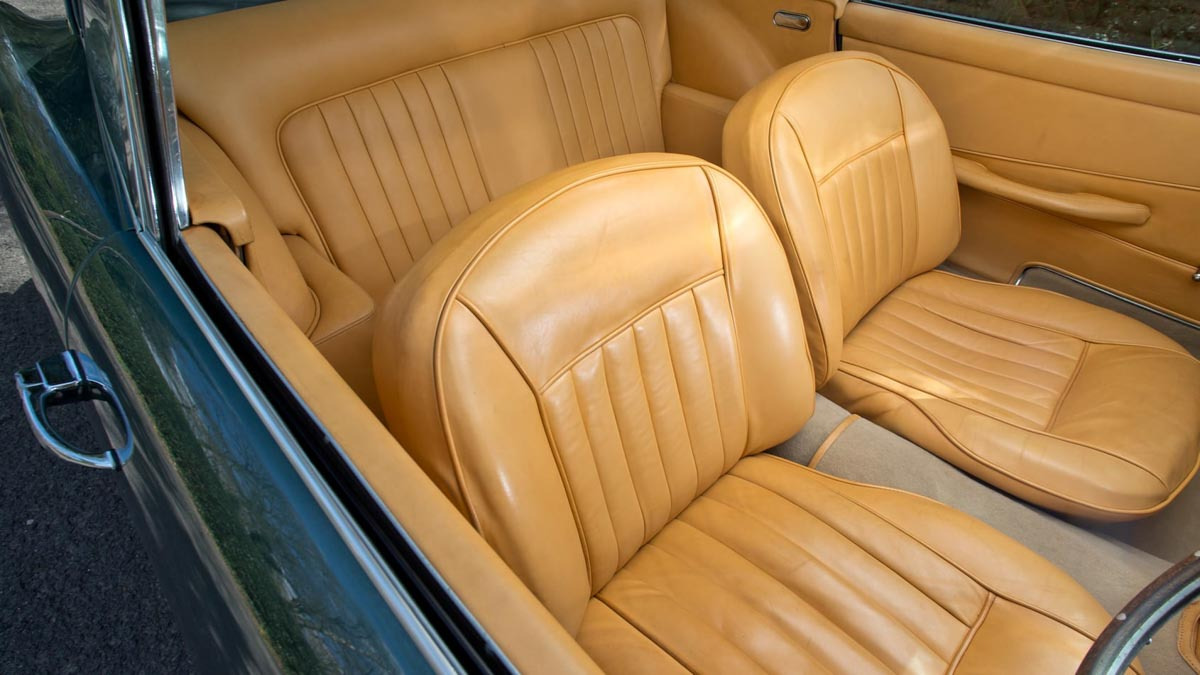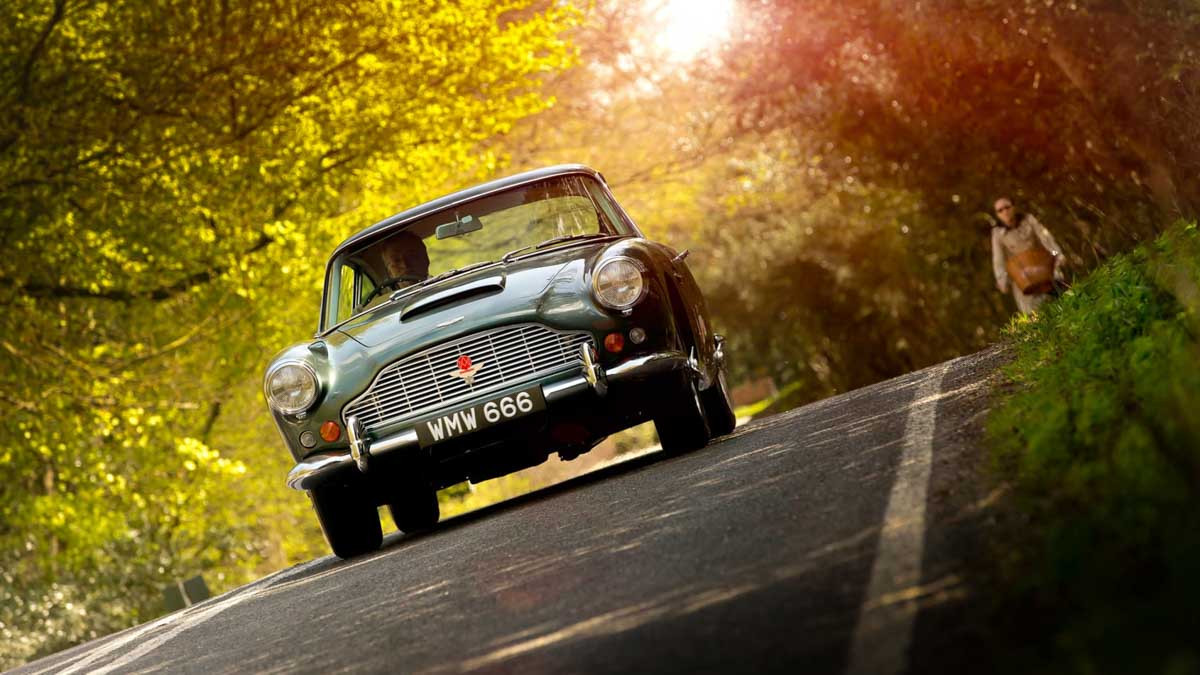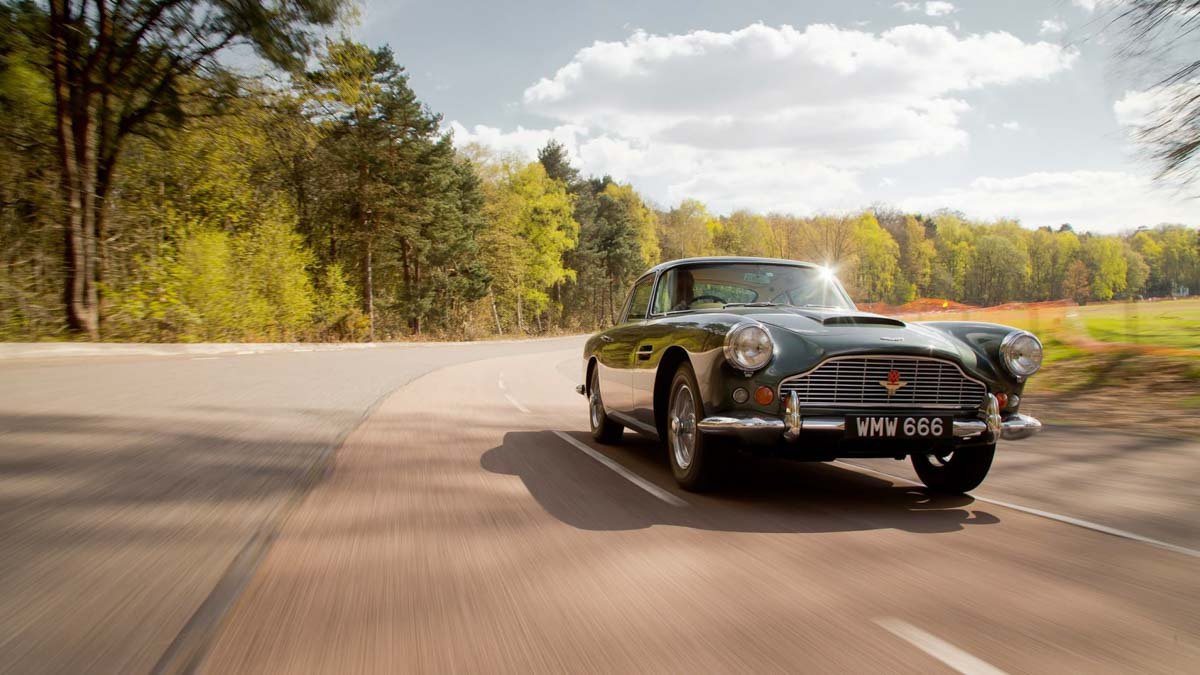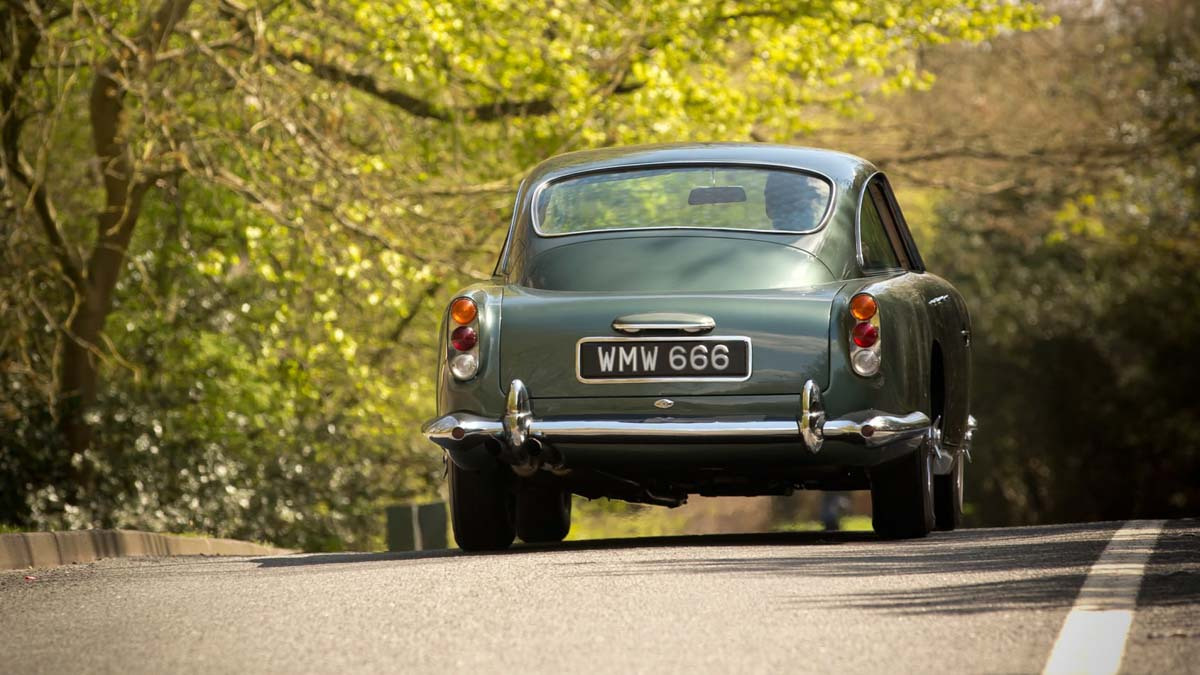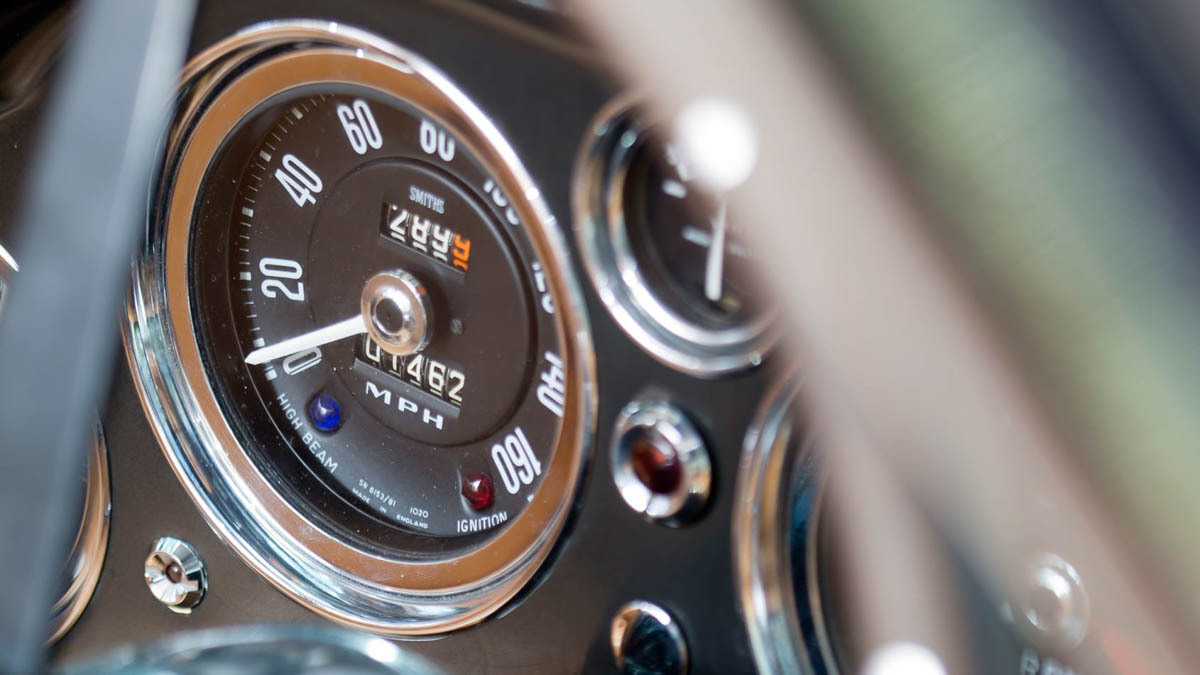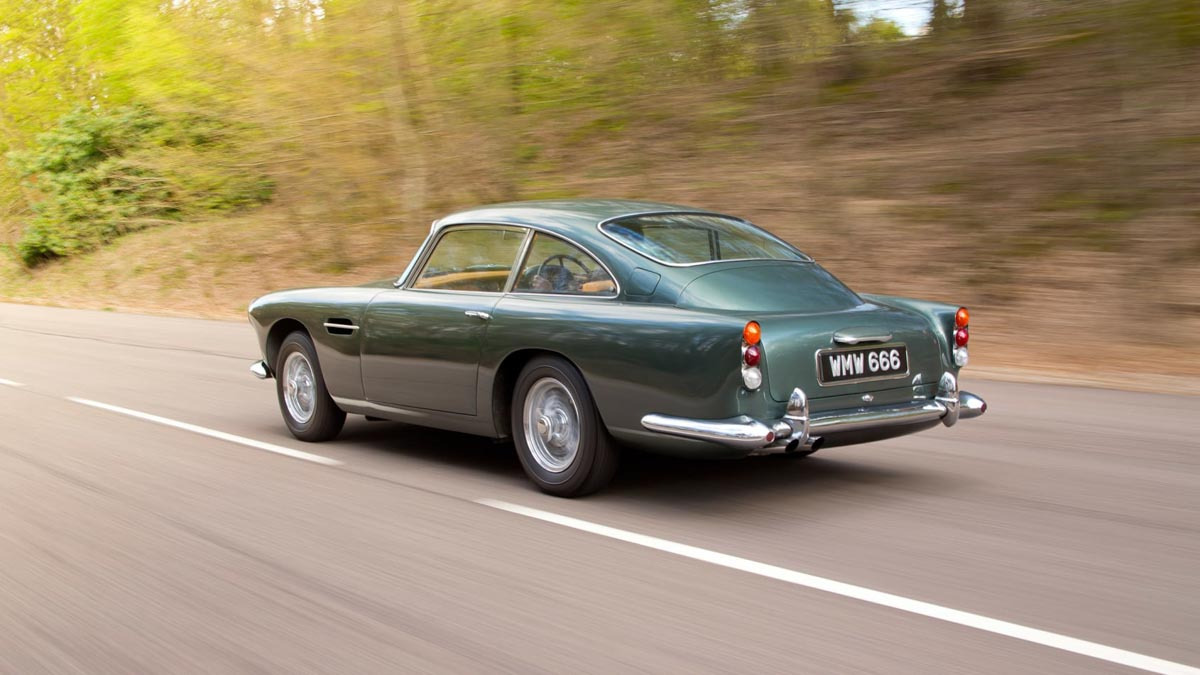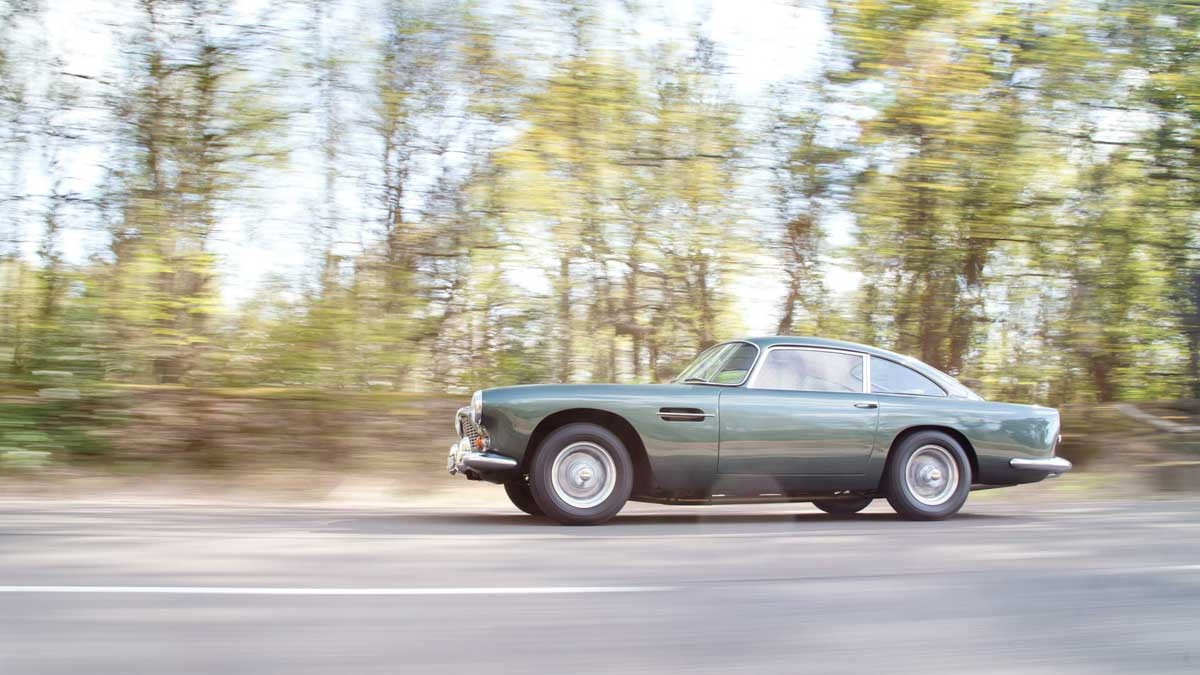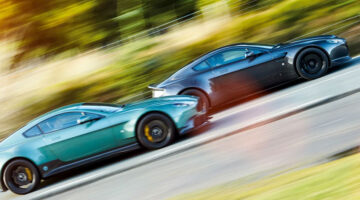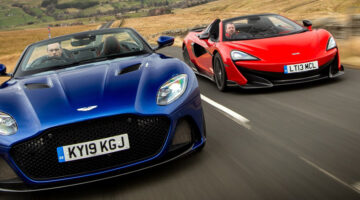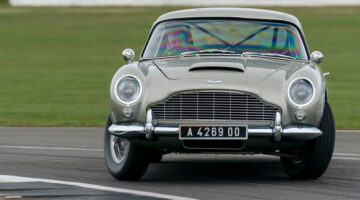1959 was a watershed year for Aston Martin. As the DBR1 swept all before it on the track, the first customers were taking deliveries of the all-new DB4. Nothing would ever be quite the same again…
It’s not a concours car,’ Nick Mee had cautioned. ‘And it doesn’t have any of the modern upgrades that a lot of owners like, so brakes, cooling, steering …pretty much everything is as it was in period. And just the standard 3.7-litre engine with the twin SUs…’
Nick, I interrupted, it sounds perfect.
And that’s exactly how it looked, too, as photographer Matt Howell and I pulled up outside the west London showrooms of Nicholas Mee & Co on a blissfully sunny late April morning. Gleaming in Forest Green, its chrome wires and three-eared spinners glinting wickedly, this 1962 Series 5 DB4 looked the absolute cat’s whiskers.
But then the DB4 always was a fabulously handsome machine. General manager John Wyer chose wisely in 1956 when he gave Touring of Milan the task of shaping the DB2/4’s replacement. The early-‘50s Aston was a well-regarded sports car in its own right – and a good-looking one too, especially in MkIII guise – but when the DB4 was unveiled in late 1958, Aston Martin vaulted effortlessly into the top flight of the world’s most desirable marques. And when the following summer the racing department beat allcomers at Le Mans and carried off the World Sportscar Championship, Britain suddenly had its own Ferrari. It even had its own Maranello, for the DB4 was the first to be wholly assembled at the new works in Newport Pagnell. In these heady days, a legend was forged, one on which arguably everything that followed has been built.
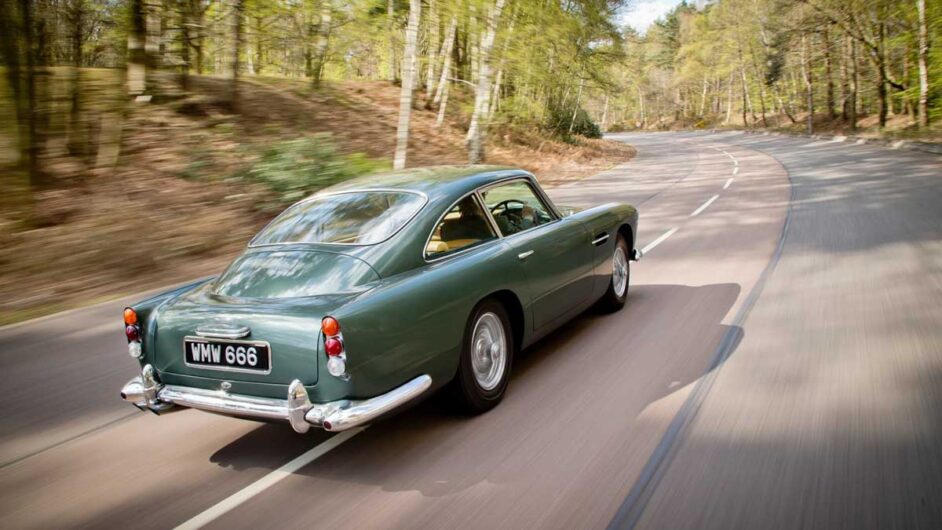
It’s worth pausing before we jump in and drive, just to consider the impact the DB4 made when it first appeared way back in October 1958 (almost two and a half years before Jaguar’s E-type, don’t forget). Here was a thoroughly modern, high performance GT, and it was received with something approaching rapture by the press. Autosport described it as the ‘safest and fastest saloon in the world’, adding: ‘It is another British achievement that will make the Italians and Germans think very hard.’ Autocar recorded a top speed of 225kph, though this was in 1960 with the Series 2 car, which had an oil cooler and larger sump capacity to allow sustained high speeds on continental roads without the fear of the overheating and (ultimately) bearing failure that had dogged the earliest examples.
This was, of course, Tadek Marek’s all-new, all-aluminium, double-overhead-cam straight six, another defining element of the Aston Martin story that arrived with the DB4. In standard tune it made its quoted peak of 240bhp at 5500rpm, with maximum torque, 240lb ft, arriving at 4250rpm.
The DB4’s underpinnings were a mixture of old and new. Touring had been given the DB4 gig after rebodying a pair of DB2/4s to wide acclaim. These extremely fetching convertibles used the company’s patented ‘superleggera’ (super-light) construction method – a lattice of small-diameter steel tubes clothed in aluminium panels – and the same system was employed for the DB4, rooted upon a steel platform chassis that included the floorpan and forward-reaching box sections to support the engine.
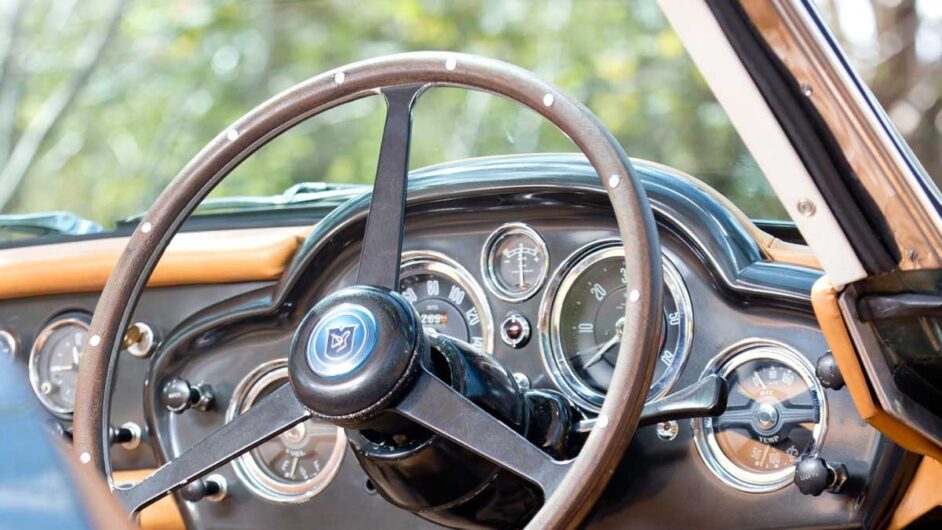
All that steel meant that the DB4 wasn’t, in fact, particularly light (around 1570kg with fluids) though it did provide a decently stiff platform from which the suspension could work.
Here, however, was arguably the DB4’s Achille’s heel. Chief engineer Harold Beach had specified wishbones at the front and a de Dion tube at the rear with a chassis-mounted differential – a layout that would have given greater individual wheel control than a live rear axle. But the noise from the David Brown gearbox was found to be too great when transmitted through a chassis-mounted diff casting, so a live axle was used instead. It was a compromise, if a pragmatic one. Unassisted rack-and-pinion steering and servo-assisted Dunlop disc brakes for all four wheels completed the mechanical package.
No question, for all its timeless good looks the DB4 was very much of its time, and it will be interesting to find out how an ‘unmodernised’ car performs in our very modern world. The cut and thrust of mid-morning traffic heading out through west London will provide the first test.
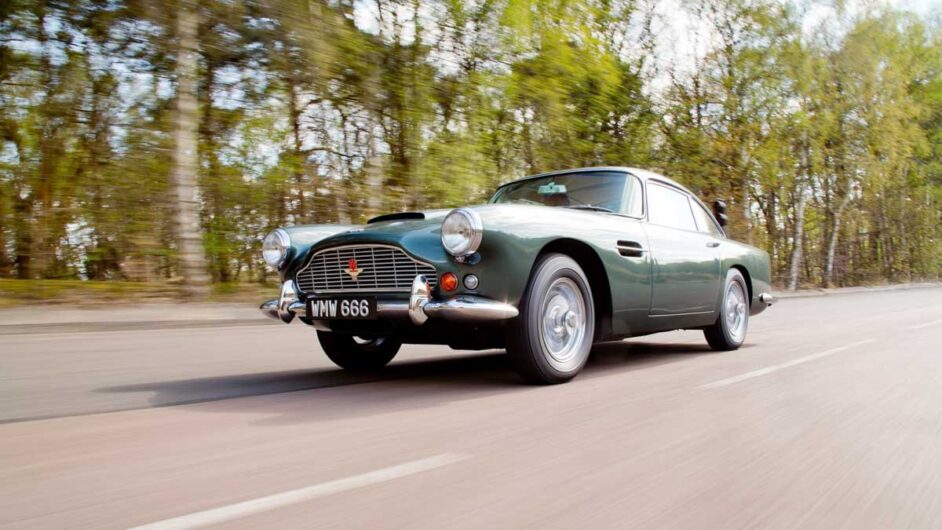
Stepping from a modern car into the DB4, the first thing you notice is how low the seat-backs are – they barely reach your shoulder-blades. You reach round for a seatbelt that isn’t there, and then you discover a similar absence of door- or wing mirrors. At which point you’re relieved to note how slim the window and door pillars are, and how good the over-the-shoulder vision. You’ll be glad of that later. The driving position’s pretty decent, too, even if the pedals are slightly offset to the right, and there’s a full complement of simply marked Smiths instruments all clearly visible through the narrow-spoked wheel. Its wooden rim is held together with rivets: you can feel their heads as you run your fingers around it, all the better to hang on to…
Twist the key in the middle of the dash and the straight six, already warm, bursts instantly into life and rumbles contentedly at a steady idle. Dip the meaty clutch, nudge the gear lever firmly forward for first and, with slightly too many revs – the throttle pedal has a heavy initial movement, mitigated by a clutch that bites softly – edge out into the side-streets of W12.
I’d been slightly apprehensive about that DB gearbox. Just four speeds, no syncro on first, a slightly agricultural mien… Popular wisdom has it that the ZF five-speeder that replaced it in the DB5 is the superior unit. In fact, though it takes a bit of learning and a dash of sensitivity to work your way around the gate, feeling the gears in, once everything’s warmed through and you’ve adapted to its natural tempo, it can be palmed around with satisfying ease.
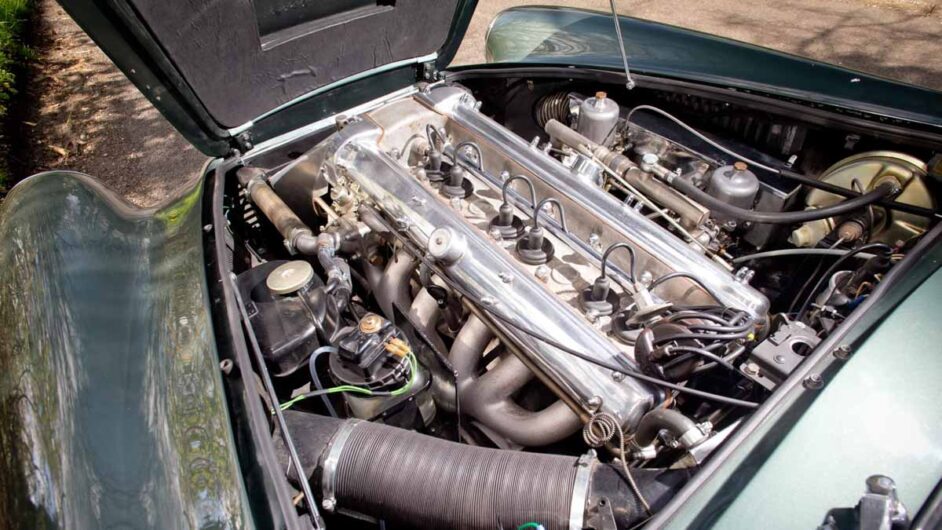
It’s certainly not my main concern as we joust with the courier bikes, the white van men and the bullet-headed thrusters in their black Audis who cut in unthinkingly. The DB4’s beautiful aluminium flanks seem naked and vulnerable as we traverse busy junctions and teeming three-lane roundabouts. It’s getting stuffy in the cockpit, so I crank the window down and the whiff of warm oily bits mingles with the scent of leather. I catch sight of the Aston’s reflection in a shop front; it looks almost surreally beautiful, crisply drawn amongst the chunky, lumpy, pedestrian-friendly shapes of modern traffic. A blip of the throttle elicits a rush of induction noise and a gruff growl from the twin exhausts. Workers on coffee breaks at pavement café tables cast what I take to be approving glances. There’s something undeniably seductive about the sight and sound of a DB4.
I’m still feeling slightly anxious about piloting someone else’s quarter-million-pound motor car (a few days after we arranged this shoot, the car was sold, so our thanks to the generous new owner for allowing us to go ahead). The DB4 isn’t especially demanding to drive, certainly not for a car born in the late-’50s, but clean gearchanges still require care and a precise hand, the brakes don’t have that instant, reassuring bite of modern systems and the steering takes a fair bit of hefting around. To be honest it’s a relief to take the slip-road for the westbound M4 and finally give the Aston its head. Held in third gear from a little above jogging pace to somewhere on the naughty side of the legal limit, acceleration swells in a most agreeable fashion, the guttural exhaust and induction roar compressing and hardening as the revs pass 4000rpm. Now that’s more like it.
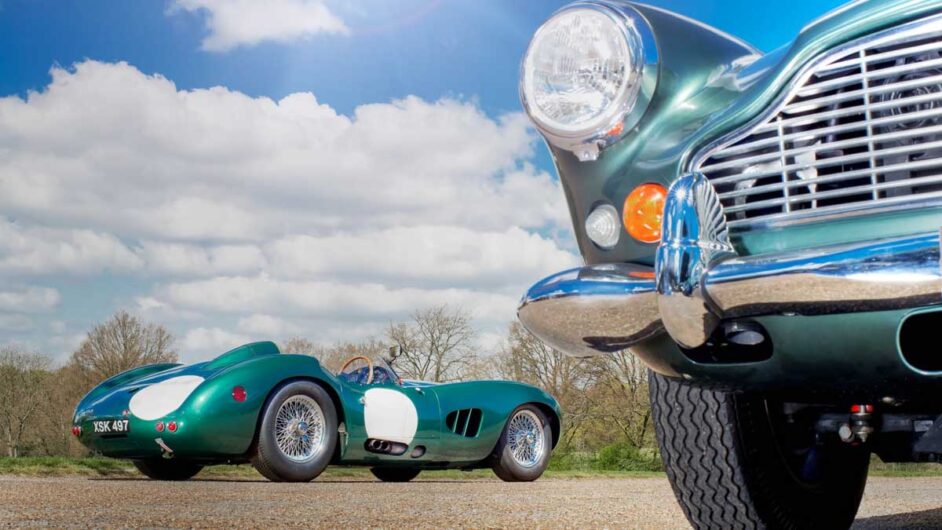
We’re heading for Ascot – not to the racecourse, but to Ferrari dealer Talacrest, which is based in rolling countryside just outside the Berkshire town. The Ferraris here are some of the rarest and most highly valued in the world, but even in this company the car we’ve come to see is special almost beyond compare. Talacrest is the current home of the Le Mans-winning DBR1, though according to boss John Collins it won’t be residing in Britain for much longer, with potential buyers from the US and Europe vying to be its next custodian. With a current value somewhere north of $26m, a request for a quick run round the block is politely declined.
We’re here to shoot DBR1/2 with DB4 – the twin peaks of the David Brown era, the two cars that established Aston Martin as a world-class constructor of sports and racing cars. Beside its racing sibling, the DB4 looks as though it’s wearing a well-cut suit; the R1, impossibly ground-hugging and voluptuous, as though it’s wearing not very much at all. Its alloy body is so thin that it would be quite possible to leave a handprint on one of those curves. Sparkling in late-spring sunshine, they look utterly sublime.
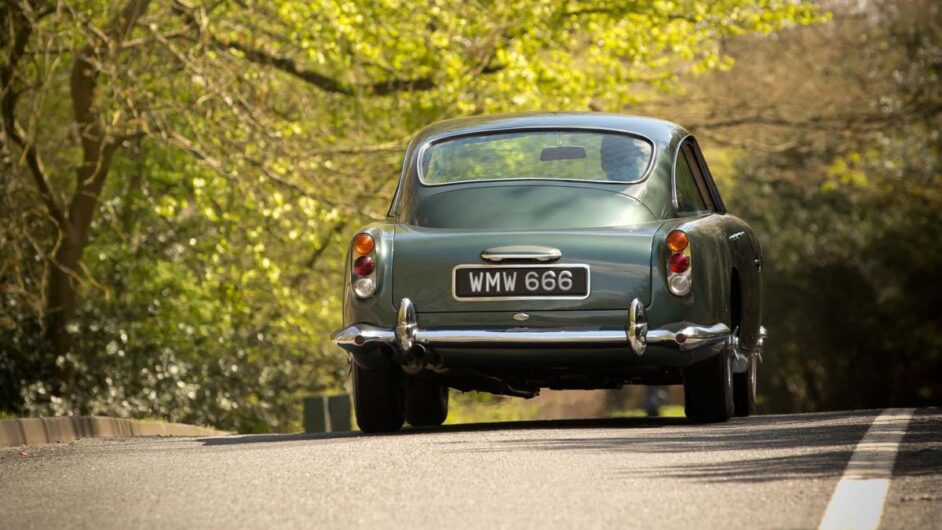
Cover shoot over, I slide back into the DB4, turn the key and… Chnnk. Nothing doing. Flat battery? The Talacrest guys give us a jump-start with a battery booster pack. All seems to be well, so we head off to take some moving shots of the Four. I’m really starting to relish this amalgam of latin-infused style and lion-hearted British engineering. Sure, the six in standard twin-SU configuration doesn’t have the punch of the triple-carb versions, never mind the twin-plug GT, but its broad spread of torque combined with excellent throttle response means it can more than hold its own in modern traffic.
The brakes, too, are perfectly adequate for regular road driving – push through the initial deadness and there’s solid stopping power, while the height and firmness of the pedal make pivoting your heel onto the accelerator and adding a blip of revs for a downchange soon feel second nature. Even the gearchanges are slotting home cleanly now – well, most of them – and on more open roads the steering’s weight is rarely an issue. We’re winding through the lanes around Sunningdale, deep in stockbroker-and-golf-club territory. By the late 1950s and early ’60s, this would have been Aston heartland and the DB4 would undoubtedly have been the car to arrive in. Dapper DB himself may even have driven these roads: he was an active member (later president) of nearby Ham Polo Club.
My flight of fancy is rudely interrupted as the DB4’s right rear wheel hits a very contemporary pothole, jolting the axle noisily and sending a shimmy through the structure. It’s a measure of how good the rest of the car is that this is so jarring – in every sense. What’s more troubling is that the Aston has begun to misfire. I notice a red warning light glowing dimly on the dashboard – seems the dynamo isn’t charging and the ignition is drawing the last few drop of juice from the battery. Sure enough, five minutes later the DB4 expires and we’re temporarily stranded. This really is the full, authentic, early- ’60s motoring exerience – and the reason so many owners opt for alternators, along with extra sound and heat insulation, uprated cooling and braking systems and all the rest of it. Photographer Matt takes the opportunity to reel off some detail shots, while Nicholas Mee & Co stalwart Graham Hudson rides to our rescue with a battery booster.
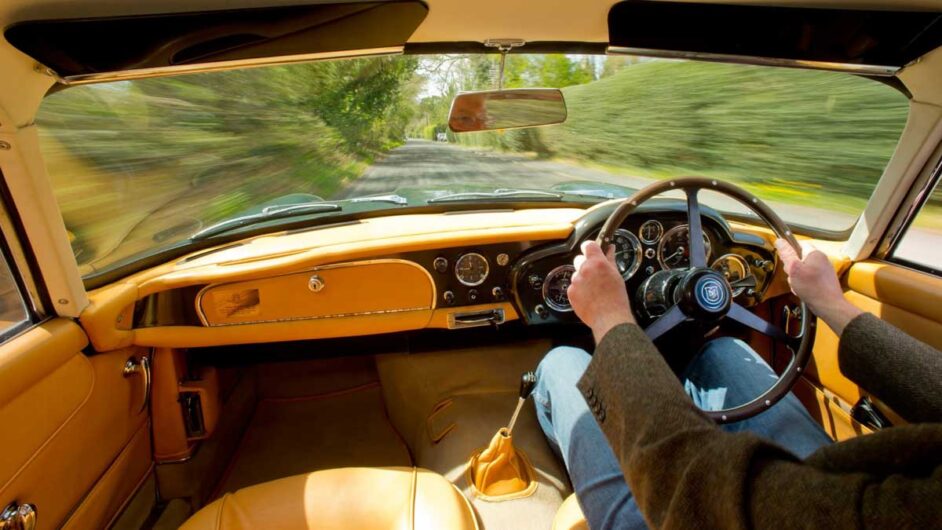
Forty-five minutes later the DB4 roars back into life, but time is pressing now and Matt is anxious to shoot some action. Fortunately the former military test track at Chertsey is only a few kilometers away. Soon I’m gunning the DB4 down the backroads, lusty six pulling smoothly now all the way to 5500rpm before I slot the next gear. This car never quite shrinks around you the way some sports cars do – partly because there’s such a lot of bonnet ahead, though the proud, rounded tops of the front wings help you place it on the road. The odd crude thump from the back axle notwithstanding, it makes very decent progress. I can’t help craving some well-judged power assistance though. It’s not so much that the steering’s heavy – yes, it takes considerably more effort than any modern car, but it’s not that heavy compared with many of the era – but its low gearing means you have to grab big armfuls of lock in tight turns or traversing urban roundabouts.
There is, of course, another way, though it takes the open expanses of the track before I dare try it. Squeeze the throttle in steady-state cornering and, predictably, the nose runs wide. Now lift off sharply and feel the car’s attitude change. A stab of throttle and it begins to pivot; suddenly you’re cornering with barely any lock at all, and adjusting your angle with your right foot. Suddenly the DB4 feels like it’s dancing. The state can be induced at such low speed, and develops in such a progressive fashion that you can easily imagine using the same technique to take the sweat out of those turns I was having to heave the DB4 through earlier. But we’ll leave that pleasure to this car’s lucky new owner.
It’s a pleasure denied to the owners of most modern machinery, but then of course that goes for so much of what makes the DB4 so appealing today. Older Astons were able to be things that modern ones simply cannot be. What makes the DB4 extraordinary is the way it set the template so perfectly for everything we still enjoy today about Aston’s best road cars – that combination of transcendently handsome but unshowy good looks, abundant and unhistrionic performance, a well-balanced chassis, and a rich and arguably unique character. That an effectively standard car can still cut it in today’s world is all the more reason to cherish it.
Thanks to Nicholas Mee – and the DB4’s new owner – for allowing us to enjoy this wonderful car (www.nicholasmee.co.uk). And thanks to John Collins at Talacrest for access to DBR1/2 (www.talacrest.com).
This article originally appeared at evo.co.uk
Copyright © evo UK, Dennis Publishing

